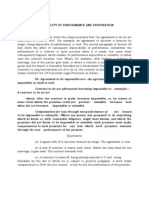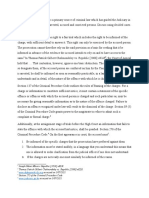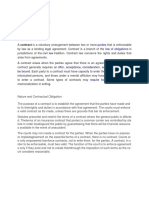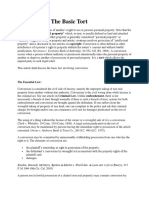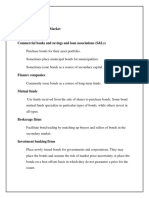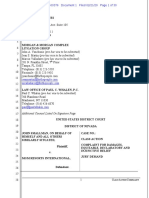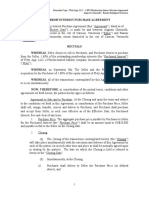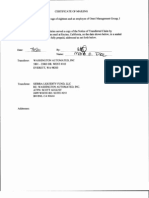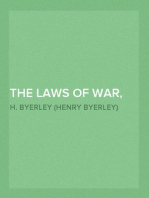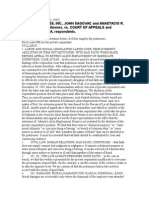Contract Law
Contract Law
Uploaded by
Syed Muhammad AhmedCopyright:
Available Formats
Contract Law
Contract Law
Uploaded by
Syed Muhammad AhmedOriginal Description:
Copyright
Available Formats
Share this document
Did you find this document useful?
Is this content inappropriate?
Copyright:
Available Formats
Contract Law
Contract Law
Uploaded by
Syed Muhammad AhmedCopyright:
Available Formats
Part C
(AC 5.1)
Distinguish between liquidated and unliquidated damages:
● Damages that may be specified in a contract as the amount to be paid to the
nonbreaching party in the event the contract is later breached.
● Clauses providing for liquidated damages are unforced if the damages were
difficult to the estimate at the time the contract was formed and if the amount
stipulated is reasonable.
● If construed to be a penalty, the clause will not be enforced.
● The amount of damages should place the innocent party in the same position
that he would have been in had the contract been property performed
● Damages can include.
● Expectation loses.
● Personal injuries.
● Disappointment, distress and discomfort.
Because the claimant has the burden of proving the amount of his loss, it is a great
convenience to him if the contract can simply state a sum which will be payable by the
defendant in the event of breach and the claimant can then sue for the state sum. On
the other hand, any such system is open to abuse if the sums might be set at a level far
higher than the loss actually suffered. The House of Lords attempted to reconcile these
arguments.
Dunlop Pneumatic Tyre v New Garage and Motor (1915):
● Where a fair sum is agreed for the payment for liquidated damages after several
different breaches of a contract, that sum will not be classed as penal.
● In deciding whether a clause is penal, ask if a clause:
● Requires an extravagant unconscionable payment in comparison with the
maximum loss which could conceivably be proved.
● Requires a greater sum of money to be paid as a secondary obligation over the
primary obligation which is replaced.
● Clauses may or may not be classed as penal depending on how the contract was
breached and if the parties relied upon the clause for certainty.
● The test for a penalty is now:
“Whether the impugned provision is a secondary obligation which imposes a determent
on the contract -breaker out of all proportion to any legitimate interest of the innocent
party in the enforcement of the primary obligation.”
Part D
(AC 3.1)
Identify the elements of actionable representation:
In order to be actionable, the representational must be material so that it would
positively influence a reasonable person to enter the contract.
● The representation made must be material.
● The representation must be known to the representation.
● The representation must be acted upon.
A deceit occurs when a misrepresentation is made with the expressed indentation of
defrauding a party, subsequently causing loss to that party.
● A clear false representation of fact or law.
● Fraud by the maker,in the sense that they knew that the representation was
false, or had no belief in its truth, or was reckless whether it was true or false.
● Action by the claimant in reliance on the representation.
● Damage suffered by the claimant in reliance on the representation.
In Connolly v Bellway Homes, the seller of development land was able to obtain
damages from the buyer on the basis that it relied upon a statement by the buyer about
the value per square foot of development land. The figure suggested by the buyer was
used as the base figure in a formula designed to provide the seller with a share of
increase in value of the side. The buyer’s representative adopted a figure of $210 per
square foot in the negotiations, giving the impression that this was comparable to other
developments.Negotiations continued in reliance on this representation and a base
figure of $212 was agreed.
(AC 3.2)
Differentiate between fraudulent,Negligent and innocent
misrepresentation:
When a false statement is made:
● Knowingly, or
● Without belief in its truth, or
● Recklessly, careless as to whether it to be true or false.
For the purpose of making a reckless statement, there is no need to prove dishonesty or
fraud: only that the statement was made without caring whether the statement was true
or not.
The difference between fraudulent misrepresentation and negligent misrepresentation is
the existence of a fraudulent intention.
There’s no reason in principle why a fraudulent misrepresentation can’t also be a
negligent misrepresentation, provided the facts of the case satisfy the test for each
cause of action.
Traditionally, damages could only be claimed for fraudulent misrepresentation. Not
negligent misrepresentation. Only the remedy of rescission was avaliable.
Section 2(1) of the Misrepresentation Act 1967 changed that. It introduced the
availability of damages as a remedy for negligent misrepresentation. Also, a court has a
discretion to refuse the remedy of rescission and award damages instead.
The pre-contractual statement was false, but the maker of the statement wasn’t
negligent in making the statement.
● The statement has become a term of the contract.
● The contract has been performed,according to s1 of the Misrepresentation Act
1967, and.
● Common law tests are satisfied.
(AC 4.3)
Examine the doctrine of frustration:
The doctrine of frustration basically talks about the impossibility of performance of the
contract.It means a contract cannot be executed because of an incident beyond the
control of parties. The performance of such a contract becomes frustrated i.e. It
becomes complicated,impossible or even illegal.
The principle of freedom to contract is a founding principle upon which the world of
commercial contracts operates. This strictly means that the parties to a contract are free
to agree on their own rights and obligations to be included in their agreement.
The doctrine of frustration in contract law was initially defined by two points, namely: (1)
the doctrine was to be only permitted where it was raised as a defence to a primary
assumption on which the agreement was reached; and (2) the parties were entitled to
insert provisions as a contingency measure to provide for the occurrence of the same.
“From the nature of the contract it is apparent that the parties contracted on the basis of
the continued existence of the particular person or chattel”.
The application of the doctrine of frustration can arise in a variety of situations. The
body of case law on the subject, however, illustrates that there are typically situations in
which the doctrine arises. Most commonly, the doctrine arises in situations in which
there is an inability to perform the contract due to the subject-matters destruction or
unavailability:
Taylor v Caldwell [1863]:
The claimant hired out a music hall in Surrey for the purpose of holding four grand
concerts. The claimant went to great expense and effort in organising the concerts.
However, a week before the first concert was due to take place the music hall was
destroyed by an accidental fire. The claimant sought to bring an action for breach of
contract for failing to provide the hall and claiming damages for the expenses incurred.
The claimant’s action for breach of contract failed. The contract had been frustrated as
the fire meant the contract was impossible to perform.
There are a variety of issues which can prevent the doctrine of frustration from
occurring. Firstly, where one party is found to have been negligent, the doctrine shall not
apply. However, negligence per se does not strictly prevent frustration from occurring,
as it is for the person claiming frustration to provide proof of the same.
Maritime National Fish Ltd v Ocean Trawlers Ltd [1935]:
The respondents owned a strem trawler, which was fitted with another traw. The vessel
could only operate as a trawler. The respondents chartered the vessel to the appellants.
According to the charterparty, the vessel could only be used in the fishing industry. The
charterparty was renewed for the year in October 1932. In March 1933, the applicants
applied to Minster to grant them licenses for five trawlers that they were operating. The
appellants named the three trawlers and the vessel in question was not among them.
Subsequently, they claimed that they were no longer bound by the charterparty as it
was frustrated by the refusal of the Minster to grant licence in respect of the steam
trawler in question.
The decision was in favour of the respondents.
(1) There was no frustration of the charterparty as the absence of a licence was due to
the fact that the appellants' choice of vessels, which were to be granted licences.
(2) Therefore, the appellants remained liable for the hire of the vessel.
You might also like
- PhonePe - Offer - Vipul Tyagi - 507023 - SignedDocument8 pagesPhonePe - Offer - Vipul Tyagi - 507023 - SignedVipul Tyagi100% (1)
- DIALOG Arrange Without SecretaryDocument6 pagesDIALOG Arrange Without SecretaryHani Hafizatul HezrinaNo ratings yet
- Dispossessory AnswerDocument1 pageDispossessory AnswerPeggy HillNo ratings yet
- Lecture Notes - Tort Law - DuressDocument18 pagesLecture Notes - Tort Law - DuressBbbbbbbbNo ratings yet
- Mandadi LawsuitDocument21 pagesMandadi LawsuitJulie MorenoNo ratings yet
- Homework Week 4Document5 pagesHomework Week 4Damalie IzaulaNo ratings yet
- Mini Miranda Warning and Dunning LeterDocument4 pagesMini Miranda Warning and Dunning LeterFreedomofMindNo ratings yet
- Gang of Five Final EntryDocument4 pagesGang of Five Final EntryFinney Law Firm, LLCNo ratings yet
- Relocation SettlementDocument5 pagesRelocation Settlementrich chast100% (1)
- TOYO - HNS Manual - ReferencialDocument47 pagesTOYO - HNS Manual - Referencialjesus paul cuellar zegarra100% (1)
- FrustrationDocument21 pagesFrustrationAruna ANo ratings yet
- Assignment On Section 18 "Misrepresentation" The Indian Contract Act, 1872Document15 pagesAssignment On Section 18 "Misrepresentation" The Indian Contract Act, 1872DeepakGupta100% (1)
- The Court of Appeal: Joseph Nduvi Mbuvi V Republic (2019) eKLRDocument2 pagesThe Court of Appeal: Joseph Nduvi Mbuvi V Republic (2019) eKLRLaelia KagikaNo ratings yet
- In Re Boardwalk Marketplace Securities Litigation, 849 F.2d 89, 2d Cir. (1988)Document4 pagesIn Re Boardwalk Marketplace Securities Litigation, 849 F.2d 89, 2d Cir. (1988)Scribd Government DocsNo ratings yet
- Release For Personal Injury: Releasor: - , at - (Address)Document4 pagesRelease For Personal Injury: Releasor: - , at - (Address)Ricci Andrea ReyesNo ratings yet
- Report On Agency ContractDocument36 pagesReport On Agency Contracttejcd1234No ratings yet
- Necessities For Proving Adverse PossessionDocument3 pagesNecessities For Proving Adverse PossessionShivang MishraNo ratings yet
- TORTS - 2 Elements and Types of TortsDocument8 pagesTORTS - 2 Elements and Types of TortsAnnabelle C. VecinalNo ratings yet
- 8 DischargeDocument33 pages8 Dischargelelsoc100% (1)
- Parties Law of Obligations Civil LawDocument6 pagesParties Law of Obligations Civil LawEljoy AgsamosamNo ratings yet
- Personal Injury Claim SettlementDocument1 pagePersonal Injury Claim SettlementinjuryclaimsettlemntNo ratings yet
- The Sale of Goods Act, 1930 PDFDocument24 pagesThe Sale of Goods Act, 1930 PDFMohan Murge walaNo ratings yet
- United States Bankruptcy CourtDocument3 pagesUnited States Bankruptcy CourtChapter 11 Dockets100% (1)
- Codification (Law) - Wikipedia PDFDocument27 pagesCodification (Law) - Wikipedia PDFHarel Santos RosaciaNo ratings yet
- Contract Is A Meeting of Minds Between Two Persons Whereby One Binds HimselfDocument1 pageContract Is A Meeting of Minds Between Two Persons Whereby One Binds HimselfIan Ag-aDoctor100% (1)
- Special Case For Contract Act UGC NETDocument8 pagesSpecial Case For Contract Act UGC NETGaurav SharmaNo ratings yet
- A. Express TermsDocument27 pagesA. Express TermscwangheichanNo ratings yet
- Fouts V Becerra (Baton Second Amendment) ComplaintDocument14 pagesFouts V Becerra (Baton Second Amendment) Complaintwolf woodNo ratings yet
- Conversion - The Basic TortDocument5 pagesConversion - The Basic Tortaridaman raghuvanshiNo ratings yet
- In The Matter of Property Seized For Forfeiture From Address 2109 320th Street, Lake View, Iowa 51450Document7 pagesIn The Matter of Property Seized For Forfeiture From Address 2109 320th Street, Lake View, Iowa 51450thesacnewsNo ratings yet
- Agency in Law of ContractDocument11 pagesAgency in Law of ContractYash Vardhan SinghNo ratings yet
- Pantum M6700 M6800 M7100 M7200 L2710 M29 Series User Guide en V1 4Document164 pagesPantum M6700 M6800 M7100 M7200 L2710 M29 Series User Guide en V1 4fara nici o grija100% (1)
- 22A444Document42 pages22A444Chris GeidnerNo ratings yet
- John v. Gikas v. United States, 250 F.2d 858, 1st Cir. (1957)Document3 pagesJohn v. Gikas v. United States, 250 F.2d 858, 1st Cir. (1957)Scribd Government Docs100% (1)
- Invouluntary Petition by CreditorDocument4 pagesInvouluntary Petition by CreditorjjNo ratings yet
- Topic - Acceptance: Presented By: Aman Matalia Rohit Kumar NaikDocument18 pagesTopic - Acceptance: Presented By: Aman Matalia Rohit Kumar NaikRohit NaikNo ratings yet
- ECOA AnnotationsDocument4 pagesECOA AnnotationsvaughansavNo ratings yet
- Attestation of A Spousal or Common-Law RelationshipDocument1 pageAttestation of A Spousal or Common-Law RelationshipvictorzhangNo ratings yet
- Used Auto BankDocument6 pagesUsed Auto Bankfabio2006No ratings yet
- Boyd v. Commissioner of IRS, 451 F.3d 8, 1st Cir. (2006)Document7 pagesBoyd v. Commissioner of IRS, 451 F.3d 8, 1st Cir. (2006)Scribd Government Docs100% (1)
- Holtzman v. Cirgadyne - Plaintiff's Memorandum of Points and AuthoritiesDocument11 pagesHoltzman v. Cirgadyne - Plaintiff's Memorandum of Points and AuthoritiesLDuquid100% (1)
- Instructions: This Affidavit Should Be Executed by The PersonDocument1 pageInstructions: This Affidavit Should Be Executed by The PersonDeviant LemurNo ratings yet
- LawsuitDocument5 pagesLawsuitAie Gapan Campus100% (1)
- Patent Assignment ModelDocument5 pagesPatent Assignment ModelMarco Balestrini100% (1)
- BondsDocument10 pagesBondsGeorge William100% (2)
- Instructions: Writing and Filing A Motion: ChecklistDocument12 pagesInstructions: Writing and Filing A Motion: ChecklistKaren PirragliaNo ratings yet
- AEC10 - Introduction To Transfer TaxDocument21 pagesAEC10 - Introduction To Transfer TaxDarrel Sapinoso100% (1)
- Complaint Smallman v. MGMDocument30 pagesComplaint Smallman v. MGMAshley ForestNo ratings yet
- Execution Copy - 1.60% Membership Interest Purchase Agreement - RARG - Flety App LLCDocument5 pagesExecution Copy - 1.60% Membership Interest Purchase Agreement - RARG - Flety App LLCaugusto chirimelliNo ratings yet
- 1 What Is TortDocument8 pages1 What Is TortDonasco Casinoo ChrisNo ratings yet
- Theft Revision NotesDocument27 pagesTheft Revision NotesSergio Santos100% (1)
- A Bird in The Hand Consideration and OneDocument26 pagesA Bird in The Hand Consideration and OneDwayne HaynesNo ratings yet
- US SignUp Forms 9-9-9Document17 pagesUS SignUp Forms 9-9-9anysia0No ratings yet
- 2018-12-14 Defendants Original Answer Verified Denial and Original Count..Document30 pages2018-12-14 Defendants Original Answer Verified Denial and Original Count..Maria HalkiasNo ratings yet
- Mercantile LawDocument37 pagesMercantile LawskrzakNo ratings yet
- EFA Agreement Early TerminationDocument2 pagesEFA Agreement Early TerminationKhoa PhanNo ratings yet
- Topic 4 Illegality & Void ContractsDocument61 pagesTopic 4 Illegality & Void ContractsRam Erfan Z. NuqmanNo ratings yet
- Jhs/u: - o /C T (I - E - 7) - JanDocument5 pagesJhs/u: - o /C T (I - E - 7) - JanChapter 11 DocketsNo ratings yet
- A Guide To Alabama Small Claims CourtsDocument4 pagesA Guide To Alabama Small Claims CourtsABC 33/40No ratings yet
- The Laws Of War, Affecting Commerce And ShippingFrom EverandThe Laws Of War, Affecting Commerce And ShippingNo ratings yet
- Tort Law and the Construction of Change: Studies in the Inevitability of HistoryFrom EverandTort Law and the Construction of Change: Studies in the Inevitability of HistoryNo ratings yet
- Ziopedia-Bank of Englan-1664Document3 pagesZiopedia-Bank of Englan-1664ahsani17No ratings yet
- Agenda of The 110th Regular SessionDocument67 pagesAgenda of The 110th Regular SessionCdeoCityCouncilNo ratings yet
- Ford Vs CADocument5 pagesFord Vs CAEller-JedManalacMendozaNo ratings yet
- Power of AttorneyDocument16 pagesPower of AttorneyOmatra f&ANo ratings yet
- Final Anticipatory Bail ManjuDocument60 pagesFinal Anticipatory Bail ManjuApoorv shankarNo ratings yet
- Comparative Analysis of Home Loans Across Different Banks inDocument55 pagesComparative Analysis of Home Loans Across Different Banks inShikha Wadwa0% (1)
- Corporate and Allied LawsDocument638 pagesCorporate and Allied LawsMayank Jain100% (1)
- BOS To Commence Investigation Into Sheriff's Office 09.07.21Document1 pageBOS To Commence Investigation Into Sheriff's Office 09.07.21News 8 WROCNo ratings yet
- Sa105 English Form-2021Document2 pagesSa105 English Form-2021Dominic NooneyNo ratings yet
- Manual Microeh20 64 enDocument157 pagesManual Microeh20 64 enSezgin YilmazNo ratings yet
- SPWP 61Document34 pagesSPWP 61Loo Lik HoNo ratings yet
- Essay 2Document2 pagesEssay 2Jesimie OriasNo ratings yet
- Hero Honda Demerger Case StudyDocument4 pagesHero Honda Demerger Case StudyAmit JainNo ratings yet
- Caroline Bettinger Lopez.Document59 pagesCaroline Bettinger Lopez.Australian Human RightsNo ratings yet
- The Central Role of Economic Freedom in Democracy: AN ÁsquezDocument4 pagesThe Central Role of Economic Freedom in Democracy: AN ÁsquezAniela Maria BrasoveanuNo ratings yet
- TCS Payslip Jul-OctDocument4 pagesTCS Payslip Jul-OctSharad WasreNo ratings yet
- Nature of The CaseDocument3 pagesNature of The CaseDylza Fia CaminoNo ratings yet
- Public and Optional Holidays 2021Document3 pagesPublic and Optional Holidays 2021Mehr Ali RazaNo ratings yet
- 1 Electric Charge and Field - 020053 - 102918Document20 pages1 Electric Charge and Field - 020053 - 102918Amit VashistNo ratings yet
- Coca-Cola Company Challenges $9 Billion Transfer Pricing AdjustmentsDocument4 pagesCoca-Cola Company Challenges $9 Billion Transfer Pricing AdjustmentsMihaEllaNo ratings yet
- OJT Waiver Guide FormDocument1 pageOJT Waiver Guide FormMargaredElisaSyMacatol50% (4)
- CIR V Fitness by DesignDocument14 pagesCIR V Fitness by Designsmtm06No ratings yet
- Kaviguru Expres Chair Car (CC) : WL WLDocument2 pagesKaviguru Expres Chair Car (CC) : WL WL0hariomprakash0No ratings yet
- Republic Act No. 8436Document74 pagesRepublic Act No. 8436Kirby HipolitoNo ratings yet
- Hindrances To PrayerDocument22 pagesHindrances To PrayerOrlean sing'anduNo ratings yet
- STRUNK V THE STATE OF CALIFORNIA Etal. NYND 16-cv-1496 (BKS / DJS) OSC WITH TRO Filed 12-15-2016 For 3 Judge Court Electoral College ChallengeDocument1,683 pagesSTRUNK V THE STATE OF CALIFORNIA Etal. NYND 16-cv-1496 (BKS / DJS) OSC WITH TRO Filed 12-15-2016 For 3 Judge Court Electoral College ChallengeChristopher Earl Strunk100% (1)










